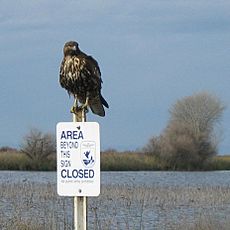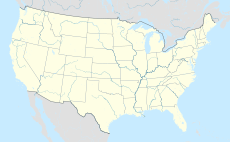Kern National Wildlife Refuge facts for kids
Quick facts for kids Kern National Wildlife Refuge |
|
|---|---|
|
IUCN Category IV (Habitat/Species Management Area)
|
|
 |
|
| Location | Kern County, California, United States |
| Nearest city | Wasco, California |
| Area | 1,249 acres (5.05 km2) |
| Established | 1960 |
| Governing body | U.S. Fish and Wildlife Service |
| Website | Kern NWR |
The Kern National Wildlife Refuge is a special protected area in California. It covers about 1,249 acres (505 square kilometers). This refuge is located in the southern part of California's San Joaquin Valley. It's about 20 miles west of the city of Delano.
This area was once part of a huge freshwater wetland. It was the biggest wetland complex in the western United States. Today, the Kern National Wildlife Refuge is a very important place. It provides a perfect winter home for many migratory birds. These include waterfowl like ducks and geese, and other water birds.
The refuge also works hard to bring back and care for natural habitats. This helps many endangered species find a safe home. It also protects a small part of the historic valley uplands. These uplands are found in the San Joaquin Desert. About 8,200 people visit the refuge each year. They come to enjoy activities like bird watching and learning about wildlife.
Contents
What is a National Wildlife Refuge?
A National Wildlife Refuge is a special place. The United States government sets these areas aside. Their main goal is to protect wild animals and their habitats. The United States Fish and Wildlife Service manages these refuges.
These places help keep nature healthy. They make sure animals have safe places to live, eat, and raise their young. Refuges also protect important plants. They are like big outdoor classrooms where people can learn about nature.
A Home for Migratory Birds
The Kern National Wildlife Refuge is super important for birds. Especially for those that travel long distances. These birds are called migratory birds. They fly south for the winter to find food and warmer weather.
The refuge has many different types of wetlands. These include marshes, ponds, and shallow water areas. These habitats are perfect for waterfowl. Ducks, geese, and swans love to rest and feed here. The refuge helps them survive their long journeys.
Many other water birds also use the refuge. You might see sandhill cranes, egrets, and herons. They all depend on the refuge's wetlands. It's a vital stop on their migration routes.
Protecting Rare and Endangered Animals
The Kern National Wildlife Refuge is not just for birds. It also helps protect animals that are in danger. These are called endangered species. Their populations are very low, and they could disappear forever.
The refuge works to restore natural habitats. This means bringing back the plants and landscapes that were once common. By doing this, they create safe homes for these rare animals. For example, they might plant native grasses or create new wetland areas.
This effort helps many different creatures. It ensures that future generations can still see these amazing animals. The refuge is a safe haven for them to live and thrive.
Exploring the Refuge
The Kern National Wildlife Refuge welcomes visitors. It offers many ways to connect with nature. You can come and watch the amazing wildlife. Bird watching is a very popular activity here.
There are often special programs for visitors. These might include guided tours or educational events. You can learn about the different birds and animals. You can also discover how the refuge helps protect them.
Some refuges also allow certain types of hunting. This is carefully managed to help control animal populations. It also provides outdoor recreation. But the main focus is always on protecting the wildlife and their homes.
How the Refuge Helps Nature
The Kern National Wildlife Refuge plays a big role in protecting our environment. It helps keep the natural balance of the area. By preserving wetlands, it cleans water and prevents floods.
It also protects a piece of California's natural history. The San Joaquin Valley once had vast wetlands. The refuge helps us remember and protect what's left. It's a living example of how important these natural spaces are.
The refuge teaches us about conservation. It shows how we can protect animals and their habitats. It's a place where nature can thrive, and people can learn to appreciate it.


